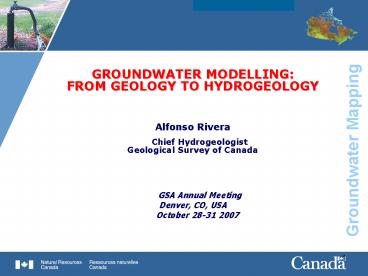GROUNDWATER MODELLING: PowerPoint PPT Presentation
1 / 20
Title: GROUNDWATER MODELLING:
1
- GROUNDWATER MODELLING
- FROM GEOLOGY TO HYDROGEOLOGY
- Alfonso RiveraChief Hydrogeologist
- Geological Survey of Canada
- GSA Annual Meeting
- Denver, CO, USA
- October 28-31 2007
2
GROUNDWATER MODELLING FROM GEOLOGY TO
HYDROGEOLOGY
- OUTLINE
- Modelling
- Geology mapping-Groundwater modelling links
- Approaches to Groundwater Modelling
- Examples of Models developed by the GSC
- Groundwater Analysis Simulation types
- Towards an integrated hydrogeological approach
- Summary and Conclusions
3
MODELLING
- So what do we mean?
- ? Modelling is a very broad term we have
- Geological Models
- Conceptual Models
- Hydrogeological models
- Mathematical models
- Analytical models
- Numerical models
- Deterministic models
- Stochastic models
4
Geology Mapping-Groundwater Modelling Links
- Groundwater investigations depend on the process
of developing a conceptual flow model as a
precursor to developing a mathematical model - leading to the development of a numerical
approximation model
- Assumptions made in the development of the
conceptual model - depend heavily on the geological framework (or
model) defining - the aquifer
Thus, the link between geological mapping and
groundwater Modelling is the building of a
conceptual model
5
Geology Mapping-Groundwater Modelling Links
6
Overview of the Hydrogeological Modelling Process
7
Approaches to Groundwater Modelling
- The flow of GW through fractured rock aquifers is
modelled using one of two types of conceptual
models - Equivalent Porous Medium (EPM)
- If the length scale of interest is large compared
with the scale of heterogeneities, such as
fracture lengths - Discrete Fractured Network (DFN)
- When the structure of the rock is highly
heterogeneous on the scale of interest - The structure of the rock is described in terms
of statistics of the fracture sets, i.e.,
fracture density and orientation
8
Approaches to Groundwater Modelling
9
Approaches to Groundwater Modelling
- Types of approaches, models
- Equivalent Porous Medium (EPM)
- Discrete Fractured Network (DFN)
- A combination of the two
(Serco, 2000)
10
Example of Methodology for Developing Conceptual
and numerical models
(Rivera et al., 2001)
11
Examples of Models developed by the GSC
12
Groundwater Analysis Simulations Types
- Two different schools of groundwater scientists
developing the science of hydrogeology - fundamental hydrogeologists, and
- environmental hydrogeologists.
- Fundamental hydrogeologists study and develop
laws and methods to quantify groundwater flow
from a theoretical perspective. - Environmental hydrogeologists use those laws and
methods to study real aquifer systems, that is,
geological formations containing and conducting
water. - The second group is the one that most closely
interacts with geologists
13
Types of Environmental (water) models
14
Towards an integrated hydrogeological approach
15
Towards an integrated hydrogeological approach
- Pre-processors include information from GIS
(MAPINFO) and are used to facilitate data
synthesis, analysis, and visualization - Simulators abound in the second phase, but the
link with pre-procesors is still lacking to a
large degree. Graphical User Interfaces (GUI)
have become a necessity in this phase. - The third phase, post-processing, has become
perhaps the most important part of the modelling
process, i.e., - Strong need for understanding GW from water
managers and public, thus visualization is a key
element in modelling. - In the future we should be able to virtually
walk the client through and inside the
simulated aquifer - Future integration of disciplines and processes
16
Differences and Issues
HM have a very different ontology as
compared to geological models! Model
Boundary conditions Dirichlet (specified h or
c) Neumann (specified c- or q-gradients) Cauchy
(combined) Medium conditions Heterogeneity,
Isotropy, Anisotrophy Porous media, Fractured
Media, discrete, EPM, Hybrid 1D, 2D, 3D Set of
parameters Hydraulic, Transport, Mechanic, Heat
P, H, C, T, K, Ss, s, Na, qi, t Type of
modelling Deterministic, stochastic Coupling Hy
dro-transport (solute transfer) Thermohaline
(flow, solute, heat) Hydro-mechanic (subsidence)
17
SUMMARY
- To build a HG Model, you need
- A numerical code to solve for a set of equations
- Discretization of space (FDM, FEM) and time
- Boundary conditions
- Initial conditions
- Set of model parameters, per node, per element or
per layer - Set of data of the stresses in the system
(pumping) - Set of data for calibration (heads, conc.,
subsidence)
If the geological model is wrong, the conceptual
model could be wrong and the HG model will not be
successful
18
SUMMARY
- Thus, geologists and hydrogeologists need to
enhance cooperation at all levels - Geologists need to learn to listen to
hydrogeologists - Hydrogeologists need to ask geologists and learn
form their input/insight
19
CONCLUSIONS
- Increased emphasis in geological mapping and
groundwater applications is observed in
interrelated disciplines of Earth sciences - A clear link between geological mappers and
groundwater modelers is still lacking - More serious efforts of communication are needed
in three interrelated disciplines geology,
hydrogeology and geomatics when dealing with GW
models - Technology and tools abound but the three domains
do not take full advantage to benefit each other
20
CONCLUSIONS
- Most important issues differences between
practitioners, e.g., HM have a very different
ontology as compared to GM - Integrated and automated platforms for modelling
3D processes in hydrogeology using experts
systems and standard ontologies are the future
and should be pursued in close cooperation
between the three domains

